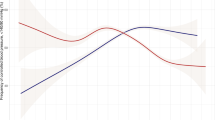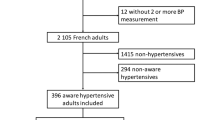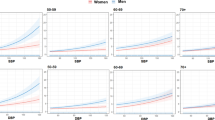Abstract
The reasons why women and men are treated with different antihypertensive drugs are not clear. Whether socioeconomic factors influence prescription patterns and blood pressure control differently in women and men has not been investigated. This cross-sectional study performed in a cohort of hypertensive patients from the Swedish Primary Care Cardiovascular Database (SPCCD) examined the influence of educational level, country of birth, gender and concomitant psychiatric disorder on prescription pattern and blood pressure control in 40 825 hypertensive patients. Men were more often than women treated with calcium channel blocker and angiotensin-converting enzyme inhibitor (ACEI), irrespective of education, country of birth and psychiatric disorder. Educational level influenced the prescription pattern to some extent, where the gender differences were reduced in patients with a higher educational level. In women, but not in men, high educational level and concomitant psychiatric disorder were associated with a higher proportion reaching target blood pressure. The predominant use of ACEI and calcium channel blockers in men is not influenced by educational level, country of birth or psychiatric disorder. Thus other explanations must be considered such as gender differences in side effects. Educational level seems to have a greater impact on reaching target blood pressure in women compared with men.
This is a preview of subscription content, access via your institution
Access options
Subscribe to this journal
Receive 12 digital issues and online access to articles
$119.00 per year
only $9.92 per issue
Buy this article
- Purchase on Springer Link
- Instant access to full article PDF
Prices may be subject to local taxes which are calculated during checkout

Similar content being viewed by others
References
Danaei G, Ding EL, Mozaffarian D, Taylor B, Rehm J, Murray CJ et al. The preventable causes of death in the United States: comparative risk assessment of dietary, lifestyle, and metabolic risk factors. PLoS Med 2009; 6 (4): e1000058.
Franklin SS, Wt Gustin, Wong ND, Larson MG, Weber MA, Kannel WB et al. Hemodynamic patterns of age-related changes in blood pressure. The Framingham Heart Study. Circulation 1997; 96 (1): 308–315.
Qvarnstrom M, Wettermark B, Ljungman C, Zarrinkoub R, Hasselstrom J, Manhem K et al. Antihypertensive treatment and control in a large primary care population of 21 167 patients. J Hum Hypertens 2011; 25 (8): 484–491.
Ljungman C KT, Shiöler L, Hjerpe P, Hasselström J, Wettermark B, Boström KB, Manhem K . Gender differences in antihypertensive drug treatment; Results from the Swedish primary care cardiovascular database (SPCCD). J Hypertens 2013; 31 (e-suppl A): e426.
Klungel OH, de Boer A, Paes AH, Seidell JC, Bakker A . Sex differences in antihypertensive drug use: determinants of the choice of medication for hypertension. J Hypertens 1998; 16 (10): 1545–1553.
Gu Q, Burt VL, Paulose-Ram R, Dillon CF . Gender differences in hypertension treatment, drug utilization patterns, and blood pressure control among US adults with hypertension: data from the National Health and Nutrition Examination Survey 1999-2004. Am J Hypertens 2008; 21 (7): 789–798.
Diez Roux AV, Chambless L, Merkin SS, Arnett D, Eigenbrodt M, Nieto FJ et al. Socioeconomic disadvantage and change in blood pressure associated with aging. Circulation 2002; 106 (6): 703–710.
Carlsson AC, Wandell PE, de Faire U, Hellenius ML . Risk factors associated with newly diagnosed high blood pressure in men and women. Am J Hypertens 2008; 21 (7): 771–777.
Loucks EB, Abrahamowicz M, Xiao Y, Lynch JW . Associations of education with 30 year life course blood pressure trajectories: Framingham Offspring Study. BMC Public Health 2011; 11: 139.
Wolf HK, Tuomilehto J, Kuulasmaa K, Domarkiene S, Cepaitis Z, Molarius A et al. Blood pressure levels in the 41 populations of the WHO MONICA Project. J Hum Hypertens 1997; 11 (11): 733–742.
Gadd M, Johansson SE, Sundquist J, Wandell P . Morbidity in cardiovascular diseases in immigrants in Sweden. J Intern Med 2003; 254 (3): 236–243.
Carlsson AC, Wandell PE, de Faire U, Hellenius ML . Prevalence of hypertension in immigrants and Swedish-born individuals, a cross-sectional study of 60-year-old men and women in Sweden. J Hypertens 2008; 26 (12): 2295–2302.
Qvarnstrom M, Kahan T, Kieler H, Brandt L, Hasselstrom J, Bengtsson Bostrom K et al. Persistence to antihypertensive drug treatment in Swedish primary healthcare. Eur J Clin Pharmacol 2013; 69 (11): 1955–1964.
De Hert M, Dekker JM, Wood D, Kahl KG, Holt RI, Moller HJ . Cardiovascular disease and diabetes in people with severe mental illness position statement from the European Psychiatric Association (EPA), supported by the European Association for the Study of Diabetes (EASD) and the European Society of Cardiology (ESC). Eur Psychiatry 2009; 24 (6): 412–424.
Crump C, Sundquist K, Winkleby MA, Sundquist J . Comorbidities and mortality in bipolar disorder: a Swedish national cohort study. JAMA Psychiatry 2013; 70 (9): 931–939.
Crump C, Winkleby MA, Sundquist K, Sundquist J . Comorbidities and mortality in persons with schizophrenia: a Swedish national cohort study. Am J Psychiatry 2013; 170 (3): 324–333.
Meng L, Chen D, Yang Y, Zheng Y, Hui R . Depression increases the risk of hypertension incidence: a meta-analysis of prospective cohort studies. J Hpertens 2012; 30 (5): 842–851.
Axon RN, Zhao Y, Egede LE . Association of depressive symptoms with all-cause and ischemic heart disease mortality in adults with self-reported hypertension. Am J Hypertens 2010; 23 (1): 30–37.
Bautista LE, Vera-Cala LM, Colombo C, Smith P . Symptoms of depression and anxiety and adherence to antihypertensive medication. Am J Hypertens 2012; 25 (4): 505–511.
Kristianson KJ, Ljunggren H, Gustafsson LL . Data extraction from a semi-structured electronic medical record system for outpatients: A model to facilitate the access and use of data for quality control and research. Health Informatics J 2009; 15 (4): 305–319.
Hjerpe P, Merlo J, Ohlsson H, Bengtsson Bostrom K, Lindblad U . Validity of registration of ICD codes and prescriptions in a research database in Swedish primary care: a cross-sectional study in Skaraborg primary care database. BMC Med Inform Decis Mak 2010; 10 (1): 23.
Ludvigsson J, Otterblad-Olausson P, Pettersson B, Ekbom A . The Swedish personal identity number: possibilities and pitfalls in healthcare and medical research. Eur J Epidemiol 2009; 24 (11): 659–667.
Wettermark B, Hammar N, MichaelFored C, Leimanis A, Otterblad Olausson P, Bergman U et al. The new Swedish Prescribed Drug Register—Opportunities for pharmacoepidemiological research and experience from the first six months. Pharmacoepidemiol Drug Saf 2007; 16 (7): 726–735.
Ludvigsson J, Andersson E, Ekbom A, Feychting M, Kim J-L, Reuterwall C et al. External review and validation of the Swedish national inpatient register. BMC Public Health 2011; 11 (1): 450.
Johansson LA, Westerling R . Comparing Swedish hospital discharge records with death certificates: implications for mortality statistics. Int J Epidemiol 2000; 29 (3): 495–502.
Hasselstrom J, Zarrinkoub R, Holmquist C, Hjerpe P, Ljungman C, Qvarnstrom M et al. The Swedish Primary Care Cardiovascular Database (SPCCD): 74 751 hypertensive primary care patients. Blood Press 2014; 23 (2): 116–125.
Hudson JI, Pope HG Jr, Glynn RJ . The cross-sectional cohort study: an underutilized design. Epidemiology 2005; 16 (3): 355–359.
Zou G . A modified poisson regression approach to prospective studies with binary data. Am J Epidemiol 2004; 159 (7): 702–706.
Klungel OH, de Boer A, Paes AH, Seidell JC, Bakker A . Sex differences in the pharmacological treatment of hypertension: a review of population-based studies. J Hypertens 1997; 15 (6): 591–600.
Os I, Bratland B, Dahlof B, Gisholt K, Syvertsen JO, Tretli S . Female preponderance for lisinopril-induced cough in hypertension. Am J Hypertens 1994; 7 (11): 1012–1015.
Mancia G, Fagard R, Narkiewicz K, Redon J, Zanchetti A, Bohm M et al. 2013 ESH/ESC Guidelines for the management of arterial hypertension: the Task Force for the management of arterial hypertension of the European Society of Hypertension (ESH) and of the European Society of Cardiology (ESC). J Hypertens 2013; 31 (7): 1281–1357.
Kajiwara A, Saruwatari J, Kita A, Oniki K, Yamamura M, Murase M et al. Younger females are at greater risk of vasodilation-related adverse symptoms caused by dihydropyridine calcium channel blockers: results of a study of 11,918 Japanese patients. Clin Drug Invest 2014; 34 (6): 431–435.
Mancia G, De Backer G, Dominiczak A, Cifkova R, Fagard R, Germano G et al. Guidelines for the management of arterial hypertension: The Task Force for the Management of Arterial Hypertension of the European Society of Hypertension (ESH) and of the European Society of Cardiology (ESC). Eur Heart J 2007; 28 (12): 1462–1536.
de Gaudemaris R, Lang T, Chatellier G, Larabi L, Lauwers-Cances V, Maitre A et al. Socioeconomic inequalities in hypertension prevalence and care: the IHPAF Study. Hypertension 2002; 39 (6): 1119–1125.
Colhoun HM, Hemingway H, Poulter NR . Socio-economic status and blood pressure: an overview analysis. J Hum Hypertens 1998; 12 (2): 91–110.
Gadd M, Sundquist J, Johansson SE, Wandell P . Do immigrants have an increased prevalence of unhealthy behaviours and risk factors for coronary heart disease? Eur J Cardiovasc Prev Rehabil 2005; 12 (6): 535–541.
Journath G, Hellenius ML, Manhem K, Kjellgren KI, Nilsson PM . Association of physician's sex with risk factor control in treated hypertensive patients from Swedish primary healthcare. J Hpertens 2008; 26 (10): 2050–2056.
Svensson S, Linell P, Kjellgren KI . Making sense of blood pressure values in follow-up appointments for hypertension. Int J Cardiol 2008; 123 (2): 108–116.
Acknowledgements
Financial support was provided by the Swedish Heart Lung Foundation, Karolinska Institutet Research Foundations, the Health & Medical Care Committee of the Regional Executive Board of the Region Västra Götaland, the Swedish Society of Medicine (Lagerströms and Lysanders foundations), the Skaraborg Research and Development Council and the Stockholm County Council (Stockholm County Drug and Therapeutics Committee, the Department of Drug Management and Informatics and the EK-group of Centre for Family and Community Medicine). The SPCCD is endorsed by the Swedish Society for Hypertension, Stroke and Vascular Medicine. We acknowledge the important contribution of all participating primary health-care centers.
Author information
Authors and Affiliations
Corresponding author
Ethics declarations
Competing interests
The authors declare no conflict of interest.
Rights and permissions
About this article
Cite this article
Ljungman, C., Kahan, T., Schiöler, L. et al. Antihypertensive treatment and control according to gender, education, country of birth and psychiatric disorder: the Swedish Primary Care Cardiovascular Database (SPCCD). J Hum Hypertens 29, 385–393 (2015). https://doi.org/10.1038/jhh.2014.100
Received:
Revised:
Accepted:
Published:
Issue Date:
DOI: https://doi.org/10.1038/jhh.2014.100
This article is cited by
-
Hypertension: sex-related differences in drug treatment, prevalence and blood pressure control in primary care
Journal of Human Hypertension (2023)
-
Sex differences in spontaneous reports on adverse drug events for common antihypertensive drugs
European Journal of Clinical Pharmacology (2018)
-
Socioeconomic differences in prevalence, awareness, control and self-management of hypertension among four minority ethnic groups, Na Xi, Li Shu, Dai and Jing Po, in rural southwest China
Journal of Human Hypertension (2017)
-
Gender Differences in Cardiovascular Drugs
Cardiovascular Drugs and Therapy (2015)



